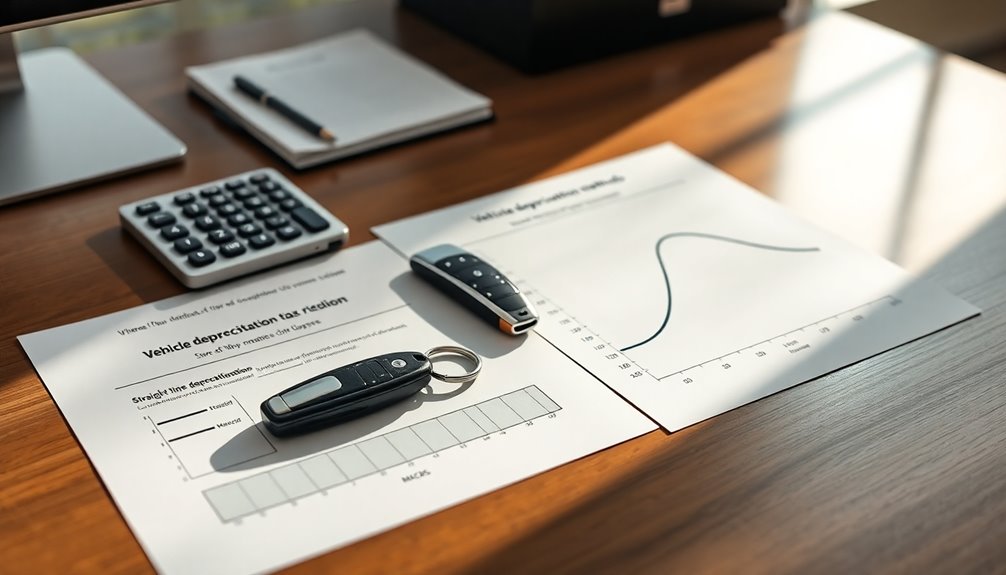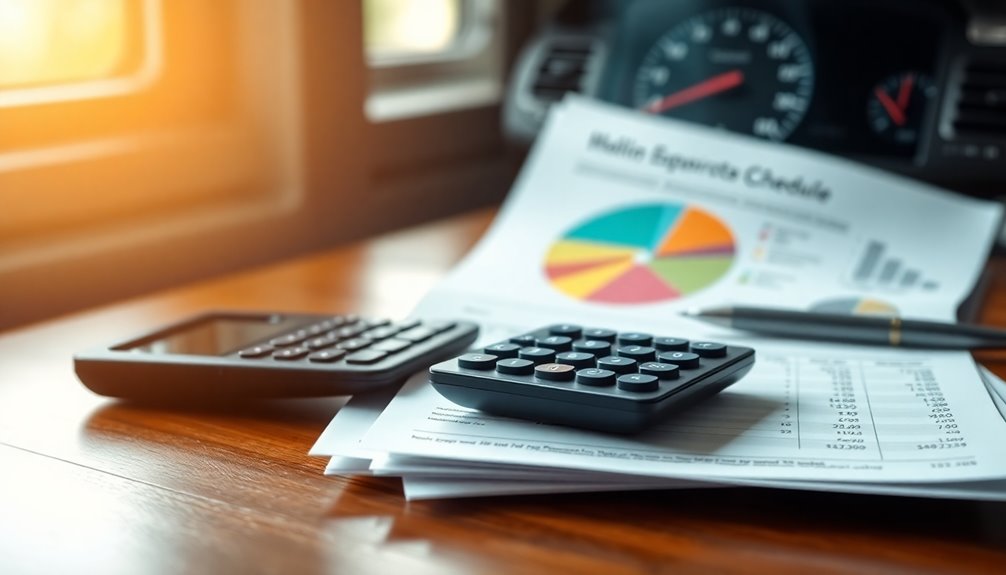To calculate vehicle depreciation for taxes, start by determining your vehicle's cost basis, which includes the purchase price and any additional costs like sales tax and fees. If your vehicle is primarily for business, use the IRS's MACRS method for accelerated depreciation if it's used over 50% of the time. Otherwise, use the straight-line method. You'll need to apply business use percentages to find your adjusted basis and maintain records. Finally, report your depreciation on IRS Form 4562. There's a lot more to consider, especially regarding deductions and reporting, so keep exploring your options.
Key Takeaways
- Determine if the vehicle qualifies for depreciation by confirming at least 50% business use.
- Calculate the vehicle's cost basis, including purchase price and additional costs like sales tax and registration.
- Choose between MACRS for accelerated depreciation or Straight-Line for lower business use, considering your tax strategy.
- For MACRS, apply the 200% declining balance method over a 5-year recovery period based on business use percentage.
- Maintain detailed records and complete IRS Form 4562 for accurate reporting of vehicle depreciation on your taxes.
Vehicle Depreciation Eligibility

To qualify for vehicle depreciation, you need to meet specific eligibility requirements. First, your vehicle must be used for business purposes at least 50% of the time. This is essential if you want to use the Modified Accelerated Cost Recovery System (MACRS). Each year, you'll need to ensure you meet this 50% threshold to keep using MACRS for depreciation.
If your vehicle serves both business and personal use, only the portion used for business is eligible for depreciation. Also, you must use your vehicle within the United States, and it can't be used for hire, such as in a car rental service.
When it comes to depreciation methods, MACRS allows for accelerated depreciation if your business use exceeds 50%. If it falls below that, you'll need to switch to straight-line depreciation. Remember, vehicles are typically depreciated over a five-year period using MACRS, with the half-year convention affecting the first and sixth years. Additionally, accurate record-keeping of your vehicle usage and expenses is crucial for compliance and accurate reporting on IRS Form 4562.
Finally, keep accurate records of your vehicle usage and expenses, as this documentation is crucial for compliance and accurate reporting on IRS Form 4562.
Establishing Cost Basis

Establishing your vehicle's cost basis is essential for accurate depreciation calculations. Start with the purchase price, which is the amount you paid for the vehicle.
Don't forget to include additional costs like sales tax, freight charges, registration, and testing fees, as these contribute to the overall cost basis. However, financing costs don't factor in, so focus only on the actual acquisition costs.
If you made any improvements to the vehicle, you can add those costs to the basis. If you used a trade-in, subtract its value from the purchase price to determine your cost basis.
Next, adjust your cost basis for business use. If your vehicle isn't used solely for business, calculate the percentage of time it's used for business purposes. It's important to remember that vehicle must be used exclusively for work to claim full depreciation.
For vehicles initially used personally, use the fair market value at the time you first used it for business. Keep detailed records to support these adjustments.
Finally, remember that your cost basis may require annual adjustments based on any depreciation you've already claimed. This meticulous tracking ensures you'll accurately calculate future depreciation deductions on your vehicle for tax purposes.
Straight-Line vs. MACRS Methods

After determining your vehicle's cost basis, the next step is deciding how to calculate its depreciation. You have two primary methods: the Straight-Line method and the MACRS method.
The Straight-Line method is straightforward. You simply divide the vehicle's cost (minus any trade-in value) by its useful life, typically five years for vehicles. This means if your vehicle costs $30,000, you'd claim $6,000 in depreciation each year.
This method is ideal if your vehicle's business use is less than 50% or if you opt for the standard mileage rate.
On the other hand, the MACRS method offers accelerated depreciation, allowing for larger deductions in the initial years. Under MACRS, your vehicle will depreciate at varying rates: 20% in Year 1, 32% in Year 2, and so on. This method is beneficial if you use your vehicle for business more than 50% of the time and allows you to recover costs more quickly due to its accelerated depreciation feature.
In essence, if you prefer consistent deductions, go for Straight-Line. But if you want bigger tax benefits earlier, consider MACRS. Your choice will depend on your vehicle's usage and your tax strategy.
Steps for MACRS Calculation

Calculating vehicle depreciation using the MACRS method involves a clear set of steps that ensure you maximize your tax benefits.
First, determine the vehicle's basis by adding the purchase price, sales tax, and any additional costs like destination charges. If applicable, subtract the trade-in value.
Next, calculate the business use percentage to find the adjusted basis by multiplying the vehicle's basis by this percentage. It is essential that the vehicle is used for business purposes over 50% of the time to qualify for depreciation deductions.
Then, identify the recovery period, which is typically five years for vehicles under MACRS, and use the 200% declining balance method for initial years. Refer to IRS Publication 946 for the applicable statutory rates and apply the appropriate convention based on when you acquired the vehicle.
For annual depreciation, calculate the first year's depreciation using the adjusted basis and the MACRS depreciation rate. For instance, if your vehicle costs $40,000 and the business use is 60%, your first-year depreciation could be $9,600.
Finally, maintain accurate records and utilize IRS Form 4562 to report your depreciation deduction and track your vehicle's remaining basis over time. This organized approach helps you effectively maximize your tax benefits.
Reporting Depreciation for Taxes

Reporting vehicle depreciation for taxes involves a systematic approach to ensure you capture all eligible deductions.
First, determine if your vehicle qualifies for depreciation by confirming that it's used for business more than 50% of the time. If so, you can choose between the Modified Accelerated Cost Recovery System (MACRS) or the straight-line method for your calculations.
To start, gather your vehicle's cost basis, which includes the purchase price, sales taxes, and any fees. Apply the business use percentage to this amount to find the depreciable value. If you're using MACRS, complete IRS Form 4562 to report your depreciation. Car depreciation allows businesses to recover vehicle costs through deductions, enhancing overall tax strategy.
It's crucial to maintain detailed records, such as a mileage log and receipts for related expenses, to support your claims. Keep in mind that if your vehicle has mixed use (personal and business), you can only depreciate the business portion.
Be aware of annual depreciation limits for passenger vehicles, and remember that heavy vehicles may have more favorable rules.
Finally, if you switch from the standard mileage rate to actual expenses, you'll need to use straight-line depreciation for the rest of the vehicle's useful life.
Frequently Asked Questions
Can I Depreciate a Leased Vehicle for Business?
You can't depreciate a leased vehicle for business because the IRS doesn't allow it.
Instead of depreciation, your lease payments are treated as operating expenses. You can deduct the business use percentage of those lease payments, but remember to track and document your usage.
If you use the vehicle for personal purposes too, only the business portion qualifies for deduction.
What Happens if I Sell My Vehicle Before Fully Depreciating It?
If you sell your vehicle before fully depreciating it, you'll need to determine the adjusted basis by subtracting the total accumulated depreciation from the vehicle's original cost.
If the sale price exceeds this adjusted basis, you'll have a gain; if it's lower, you'll incur a loss.
Gains may be subject to depreciation recapture, so keep accurate records of your deductions to ensure you report everything correctly on your tax return.
Are There Limits on the Amount I Can Depreciate?
Yes, there are limits on how much you can depreciate a vehicle.
For 2024, if your vehicle qualifies for bonus depreciation, the first-year limit is $20,400, followed by $19,800, $11,900, and $7,160 in subsequent years.
If bonus depreciation doesn't apply, the first-year limit drops to $12,400.
Keep in mind that vehicles over 6,000 lbs are exempt from these limits, so be sure to check the specifics for your situation.
How Do I Adjust Depreciation if My Business Use Changes?
If your business use changes, you'll need to adjust your vehicle's depreciation accordingly.
First, assess your new business use percentage; if it drops below 50%, switch to the straight-line method.
Divide the depreciable basis by the remaining useful life.
Keep detailed records of mileage and any changes in usage.
Document everything meticulously, as it's essential for accurate calculations and compliance with IRS regulations.
Regular updates ensure your records stay accurate.
Can I Use Different Methods for Different Vehicles?
Yes, you can use different methods for different vehicles.
If one vehicle is primarily for business use and another is personal, you might choose MACRS for the business vehicle and straight-line depreciation for the personal one.
Just make sure you follow the guidelines for each method and keep accurate records.
It's also a good idea to consult a tax professional to ensure you're maximizing your deductions while staying compliant with regulations.
Conclusion
In summary, calculating vehicle depreciation for taxes is straightforward if you know the steps. Remember to determine your vehicle's eligibility and establish the cost basis before choosing between straight-line and MACRS methods. By following the MACRS calculation steps, you can accurately report your depreciation on your taxes. This not only helps you reduce your taxable income but also maximizes your deductions. Stay organized, and you'll make the most of your vehicle investment!









